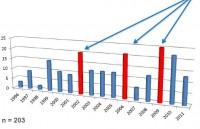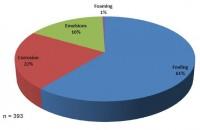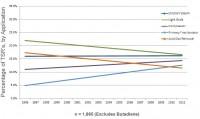
Senior R & D Manager Chris Morrison of Nalco's Energy Services division has discovered buried treasure. Contained in their Technical Support Request (TSR) database is 15 years of very well categorized data about every Energy Services customer issue that could not be resolved at the field resource level. This trove of over 4,000 projects and investigations allows Nalco to look for trends over time, across product lines, in different customer processes and at various points of the business cycle.
Historical and economic trends

Why would 9-11, Hurricane Katrina, and the recent financial crisis be events whose effects show up in the TSR data? Each of those events caused a significant increase in the price of crude oil. Twelve to eighteen months later, the effects of a shift towards cheaper gas feedstocks, reduced chemicals usage and relaxed preventative maintenance at the petrochemicals plant caused process problems that resulted in a significant increase in tech support requests. This trend phenomena will allow Nalco to be both more proactive in the field when the next spike hits and better prepared to meet the resultant demand spike.

Isolating the source
In order to provide focused training for the field staff and to direct product formulation or reformulation, it is invaluable to identify the greatest frequency of problems in the process. If foaming problems, for example, only account for 1% of the issues in a process/product line, very little time should be spent teaching diagnosis techniques or researching a new defoamer. By carefully parsing the TSR data, Nalco can maximize the effectiveness of the resources at its command.
What the future holds

To be more proactive in support efforts, it is helpful to know if the situation in the field is changing. Trending the data across the various unit operations allows the company to identify growing problem areas to pinpoint the possible need for more significant R&D and/or training efforts. With good discovery at the customer site, the reasons behind the shift can make it easier to provide cost effective (profitable for both parties) solutions. By determining whether the problem area is a result of poor control, improper usage, or changes in process and feedstock, company can make corrections that address issues with an approach that is more rifle than shotgun.
Does the company use the data to make commercial decisions? Most definitely. Trends in the TSR data can point to areas for additional process and product development, can provide confirmation (or not) of past program effectiveness, and serve as a tool for effective long-term resource planning.

For further information
Contact Christopher Morrison, Ph.D. at Nalco Energy Services in Sugarland, TX.
..
.


